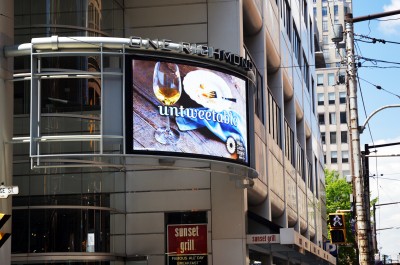Transportation safety review
In response to some of the aforementioned concerns, a transportation safety study was undertaken, based on existing literature—including Safety Impacts of the Emerging Digital Display Technology for Outdoor Advertising Signs, published in 2009—and a statistical analysis of traffic along Toronto’s Gardiner Expressway, which is flanked by many billboards, including some digital ones. (Specifically, the stretch of the expressway between Dufferin Street and Strachan Avenue, referred to by the city as the ‘Gardiner Gateway,’ has been designated a special sign district.)
Conducted by Cima+, an engineering company, the analysis focused on areas between signs and the points from which they are visible to drivers. The study found no statistically significant increase in collisions or other traffic incidents near the signs, although it did determine electronic signs can be more distracting than other signs.
This finding was supported by the public opinion survey. When Ipsos Reid asked Toronto drivers about sources of distraction, 52 per cent said electronic or illuminated signs are distracting—roughly on par with Global Positioning System (GPS) and road-map displays—compared to only 18 per cent finding ‘traditional’ non-electric signs distracting.
Studying sign types
The following are the sign types included in the current study:
Illuminated signs
The majority of third-party signs in Toronto are illuminated, whether they are used for advertising, direction or identification. They are permitted throughout the city and often located close to residential or open-space land use.
The sign bylaw incorporates requirements with regard to brightness levels at different times of day.
Readograph signs
Whether they are EMCs or physical letter inserts on a board, readograph signs are commonly integrated into larger sign structures. They are often used for such institutions as schools, churches and community centres.
Toronto’s sign bylaw restricts them to displaying only alphanumeric copy, i.e. no images, and they are generally limited to 50 per cent of the total sign face area. As with illuminated signs, there are controls over EMC brightness, hours of operation and message transitions and dwell time.
‘Static’ digital signs
There is high demand for ‘static’ digital signage, which rotates through changeable messages without motion. These signs are often found as stand-alone billboards, but can also be integrated into structures.
Toronto’s sign bylaw restricts this type to two areas of the city—i.e. the Yonge-Dundas Square and Gardiner Gateway special sign districts—with controls on brightness, message transitions (one second, no effects), dwell time (10 seconds) and hours of operation.
‘Moving’ digital signs
There is less demand for full-motion third-party outdoor digital signs, which in Toronto are limited by the sign bylaw to the Yonge-Dundas Square special sign district (although variances have resulted in some being installed elsewhere). Like static digital signs, they can be stand-alone models or integrated with other signs. The sign bylaw controls their brightness and hours of operation.
Projected digital signage
Digital projections are used in Toronto at night for advertising, art installations (often incorporating sponsorship messages) and special events. They are not currently permitted under the sign bylaw, as they often involve multiple properties and would be complicated to deal with in a bylaw. They are considered signs, but do not have any structure associated with them.






